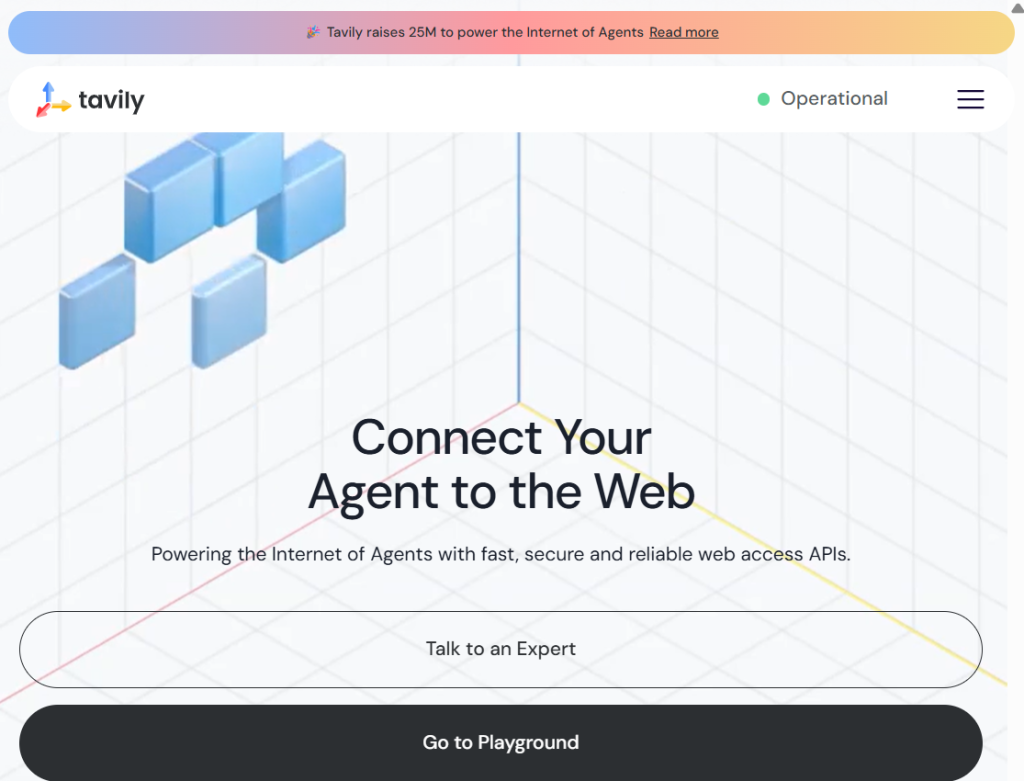Tavily Raises $25M Series A to Power the Next Generation of AI Agent Intelligence
August 12, 2025
byFenoms Start-Ups

Tavily, founded by Rotem Weiss, has raised $25 million in Series A funding, co-led by Insight Partners and Alpha Wave Global. This substantial capital comes at a time when AI infrastructure is not just a differentiator - it’s a necessity. Tavily’s platform provides real-time, compliant web connectivity to AI agents in a developer-friendly, scalable, privacy-safe format. Since its launch, the product has been adopted by tens of thousands of developers and adopted across teams at companies like Cohere, Groq, MongoDB, and Writer - all without paid marketing. That sort of organic traction suggests this may be one of the infrastructure-layer hits of 2025.
Real-Time Web Access for AI Agents
At the heart of Tavily is a real-time search API, built for LLMs, that removes the hallucination risk by giving AI agents access to fresh, trustworthy web data. Unlike static knowledge bases or limited vector stores, Tavily’s API delivers updates within milliseconds and handles agent prompt retrieval dynamically. Whether agents need to pull the latest regulations, financial data, or legal precedents, Tavily ensures they can ask and receive up-to-date answers - effectively giving AI agents their own pulse on the global web.
For founders building on Tavily, the confidence of real-time knowledge transforms agent performance from buggy guesses to informed decisions. It's not just about search - it’s about agency.
Founder Insight: Make the Infrastructure Hard to Replace
Here’s a strategic gem hidden right in the middle: the best infrastructure tools are not just part of the stack - they’re what the stack stabilizes on. Tavily chose to build as a foundational layer. Developers embed it not because it’s fancy, but because it solves real limitations in agent reliability and timeliness. That embeds Tavily into products, not just features. Want long-term product stickiness? Build something that products can’t function without.
Investors Betting on Infrastructure, Not Hype
Backing this round is a powerhouse lineup:
- Insight Partners, known for scaling category-defining developer tools and enterprise platforms.
- Alpha Wave Global, with deep investments in AI-first infrastructure.
- Their confidence reflects Tavily’s trajectory - from open-source origins to enterprise adoption - recognizing this as infrastructure, not experiment.
This isn’t a marketing splash - it’s a serious endorsement of flow-layer adoption across AI ecosystems.
What the Funding Powers Next
With a $25M war chest, Tavily is accelerating across several dimensions:
- Infrastructure scaling: Global deployment nodes with low latency to regions like Europe, Asia, and South America.
- Enterprise readiness: Compliance modules for privacy, audit logs, zero-knowledge retrieval, and data governance workflows.
- Developer ecosystem: Prebuilt SDKs, plugin system, and ready-to-use agent templates for popular use cases like email summarization, regulatory search, and enterprise knowledge queries.
- Commercialization: Partner integrations with RAG builders like LangChain, LlamaIndex, and enterprise platforms, plus a global sales team to drive enterprise adoption.
These investments aren’t vanity - they’re purpose-built for scale, use, and trust.
Market Outlook: Why Timing Aligns Perfect Timing
The market context makes Tavily’s timing beautifully aligned:
- AI Infrastructure Growing Exponentially
The global AI infrastructure market is projected to grow from $87 billion in 2023 to $181 billion by 2028, nearly 15% CAGR. Real-time agent utilities are a key infrastructure pillar. - RAG Workflows Become Normative
By 2025, over 60% of enterprise AI applications will rely on Retrieval-Augmented Generation. Yet, internal LLM pipelines lack a standard, real-time search layer—forcing developers to build brittle data-fetching themselves. - Latency Becomes Usability
Developer and enterprise users now expect sub-100ms response times. Search APIs that deliver real-time intelligence become table stakes, not luxuries. - AI Compliance Pressures
Regulatory scrutiny on AI is rising, especially around hallucination and data traceability. Tavily’s audit-friendly architecture signals future-fit infrastructure choices for enterprises.
Combined, these forces are creating explosive demand for real-time AI agent infrastructure. Tavily is not just in demand—it’s structurally needed.
Why This Infrastructure Play Matters
When your tool powers agent reliability, agent safety, and agent uptime, you aren’t just selling features—you’re enabling entirely new business models. For founders, launching infrastructure that’s irreversible—that users can’t untangle without losing utility—is how you build platforms that matter ten years from now.
Why the Market Is Ripe for This
Three market dynamics put Tavily at a perfect inflection point:
- Proliferation of agent deployment: Every modern vertical - finance, health, legal - is building internal AI agents that rely on fresh data.
- Rising hallucination concerns: Static AI + outdated corpora are fragile. Enterprises demand agents with “web reflex” - the ability to fetch live data.
- Emergence of RAG as standard: Retrieval-Augmented Generation is no longer niche - it’s mainstream for care, legal, and financial AI workflows.
Tavily sits at the confluence of those trends, filling a yawning infrastructure gap.
Ecosystem Impact: Infrastructure-Wins Compound
The real magic of infrastructure is how it compounds adoption. As developers use Tavily in workflow apps, BotOps tools, or internal platforms, more emergent use cases proliferate - from assistive pre-fills in CRMs to compliance bots that auto-verify contract clauses. That’s powerful natural growth, born of utility.
That compounding adoption - first in dev environments, then in enterprise systems - is what turns infrastructure into gravity.
Bigger Picture: AI Needs Live Data to Stay Alive
As AI tools become integral, static datasets become outdated. Real-time access is what keeps AI relevant. Tavily’s approach ensures agents stay current, credible, and context-aware. And as the AI stack evolves, every layer above - UI, orchestration engines, domain vocabulary - grows stronger with real-time facts underneath.
That’s where scalable, productive AI systems actually get built.









